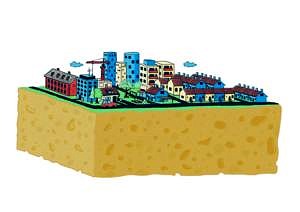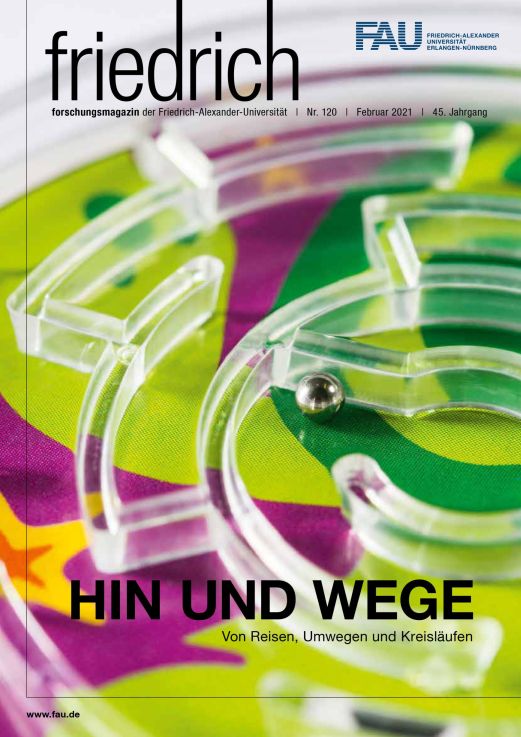What goes around comes around
Cycles have an important role to play in nature and technology, as demonstrated by water in the natural world and ventilation in an energy-efficient home.
The water on our planet is constantly on the move: it flows downstream in rivers and streams, some evaporates from oceans and lakes, and moisture is carried in the air. From this moisture, clouds form and precipitation falls. A considerable part seeps into the ground, where it continues to play an important role even if we cannot see it by adding to our groundwater and feeding into bodies of water on the surface. This water cycle is not only the basis for all life on Earth, it also shapes the surface of our planet and has a critical role to play in terms of the climate. In looking at the water cycle by analysing stable isotopes, Prof. Johannes Barth, PhD and his team at the Chair of Applied Geology are investigating an important natural force which is vital for the environment, society and life itself.
Our most important resource
‘Water is by far the most important resource for the human race. Every year we take an estimated 600 cubic kilometres of water from the groundwater alone for irrigation purposes, for industry and for private households across the globe,’ explains Barth, who specialises in hydrogeology and geochemistry. If this water was spread evenly over the area covered by Erlangen, the town would be covered by a column of water approximately 7800 metres high, comparable in height to the summits of the highest mountain range in the world, the Himalayas.
Picturing the gigantic volume of water we use like this makes the importance of replenishing groundwater clear. If large areas in cities are sealed off with concrete and tarmac, less water can seep into the ground and the water cycle no longer works the way it should. ‘We should move away from sealed ground and design towns and cities which soak up water like a sponge and retain it instead,’ explains Johannes Barth.
Sponge city

With climate change causing more frequent periods of drought in central Europe as has been the case in recent years, the concept of a sponge city with numerous green areas and plants growing up walls and on roofs could really come into its own. Instead of draining rainwater away through the sewer system, water is stored in the ground and in vegetation. The recent dry summers have highlighted the importance of having water stored like this, with trees in many towns and cities suffering badly from a lack of water. In a sponge city, rainwater or snowmelt can seep into the groundwater during the winter, and plants in green belts and parks then transport the moisture from the soil rapidly back upwards during the summer and release it into the air via their leaves. The plants thus increase the amount of moisture available in the air and cool the city’s microclimate at the same time.
The same phenomenon is seen with the water cycle outside of towns and cities, which explains why the air at the height of the summer is normally much more pleasant in a forest than in the concrete jungle of a city or on a stubble field where hardly anything grows. This continual water cycle also affects the global climate, as plants filter the greenhouse gas carbon dioxide out of the air during photosynthesis and use it to make biomolecules they need for themselves. ‘Depending on the plant and its age, up to one thousand water molecules have to be transported from the roots to the leaves in order to take a single molecule of carbon dioxide from the air,’ says Johannes Barth.
Isotope analyses
Johannes Barth and his team realised the extent to which these processes influence the climate when investigating the water cycle underground and in rivers, streams and lakes by analysing isotopes. Their research often focuses on oxygen atoms, most of which in the atmosphere (99.76 percent) are of the type isotope16O, whilst only 0.20 percent are of the slightly heavier type isotope 18O. A water molecule evaporates more easily if it contains the lighter and more common 16O isotope. Johannes Barth describes the principle behind such isotope analyses as follows: ‘In a warm summer when rates of evaporation are high, the water in rivers and lakes has less 16O, whilst the proportion of isotope 18O increases.
If we take water samples regularly from a river estuary and determine which oxygen isotopes it contains, we can calculate how much water evaporated over a certain period in the entire drainage basin.’
Plants also release water from their leaves during photosynthesis, but the isotopes differ from those released simply as a result of evaporation. Johannes Barth can therefore measure how much photosynthesis the plants in the drainage basin of a body of water have carried out, absorbing carbon dioxide from the air in the process. The team also analysed isotopes from other elements such as hydrogen and carbon which are present in water and the substances dissolved in it.
Carbon cycle
Using these methods, the group also tracked down micro-organisms which decompose plant debris and other organic substances and produce carbon dioxide as a result. When groundwater then bubbles to the surface as a spring, these processes mean that it is rich in carbon dioxide, which is rapidly released into the air. ‘We are talking about considerable quantities, but until now we haven’t really documented what exactly these processes involve,’ explains Johannes Barth.
If the water passes through a slowly flowing river or a lake in the next stage of the cycle, algae consume carbon dioxide and reduce the quantities of this greenhouse gas which are released, at least during the day. In the Canadian Saint Lawrence river, Johannes Barth discovered that these life cycles are considerably more active near the riverbanks than in the middle of the river. Johannes Barth explains that another important area of his research focuses on better understanding complex interactions such as these, which can in turn help us to assess the impact of the water cycle on the environment and the climate more accurately.
A breath of fresh air for energy-efficient homes
Bastian Schöneberger from the Institute of Fluid Mechanics tackles climate change from another perspective. His research also focuses on a cyclical flow, but rather than dealing directly with nature, he is concerned with how to boost the transition to renewable energy. One crucial aspect in Germany is finding environmentally friendly ways to heat buildings and make homes more energy-efficient. Buildings can be renovated and new energy-efficient homes built, but people should avoid opening windows in buildings like these as far as possible, as this does not only let fresh air into the house, but also loses a lot of warm air and severely jeopardises the energy efficiency in the process.
This in itself wouldn’t be a major problem, although people may be reluctant to change their habits, but the main problem is that in a normal 90 square metre flat, approximately seven litres of water vapour are released into the air every day as a result of cooking, washing and cleaning or is exhaled by plants, animals and people. As this moisture can rapidly lead to mould on the walls if the house is not ventilated regularly, Bastian Schöneberger is looking into ways to transport water continuously out of the building by means of an automatic air circulation system.
Heat exchangers

The most energy-efficient way to ventilate a building is to use heat exchangers built into large openings in an outside wall. The warm air flowing out of the building heats up the incoming air at a contact surface. The larger the surface, the more energy can be regained. One way to increase the surface area is for the air in a heat exchanger to be fed through a spiral.
Bastian Schöneberger adds that a heat exchange system like this can also be used in conjunction with a rotary heat exchanger. Rotary heat exchangers are fitted with a grid of approximately 40 centimetres diameter which rotates slowly. Warm air from the room flows out towards the outside at the bottom, warming up the grid. The thermal wheel rotates and the parts of the grid which have been warmed move to the top, where they meet the cold air coming in from outside and warm it up a little. Bastian Schöneberger explains that there are various different options for how best to combine the two systems, depending on the temperature of the outside air: you can choose to run the thermal wheel and the standard heat exchanger at the same time, or only one of the systems or neither of them.
Condensation
However, there is still one problem: warm air can carry much more moisture than cold air. In winter, the moisture in the air which is flowing towards the outside and cooling down often condenses. This condensation gathers in a channel and drips out the outside of the building. However, problems can also arise if the temperature inside and outside the building is similar and only a very little condensation is formed: ‘In order to prevent germs growing in stagnant condensation water, it makes sense to use plastic components and possibly add an anti-bacterial substance,’ explains Bastian Schöneberger.
The researcher is using computer simulations to work out how best to fine-tune the ventilation system including fans and air filters to cope with outside temperatures ranging from -25 to +50 degrees Celsius His aim is to draw up a ventilation concept which can be used in virtually all regions across the globe.
About the author
Roland Knauer has a doctoral degree in natural sciences, and lives and works as a journalist and author with a focus on natural sciences in Lehnin.
FAU research magazine friedrich
 This article first appeared in our research magazine friedrich. You can order the print issue (only available in German) free of charge at presse@fau.de.
This article first appeared in our research magazine friedrich. You can order the print issue (only available in German) free of charge at presse@fau.de.
